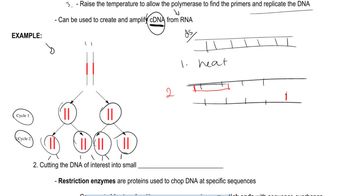Table of contents
- 1. Introduction to Genetics51m
- 2. Mendel's Laws of Inheritance3h 37m
- 3. Extensions to Mendelian Inheritance2h 41m
- 4. Genetic Mapping and Linkage2h 28m
- 5. Genetics of Bacteria and Viruses1h 21m
- 6. Chromosomal Variation1h 48m
- 7. DNA and Chromosome Structure56m
- 8. DNA Replication1h 10m
- 9. Mitosis and Meiosis1h 34m
- 10. Transcription1h 0m
- 11. Translation58m
- 12. Gene Regulation in Prokaryotes1h 19m
- 13. Gene Regulation in Eukaryotes44m
- 14. Genetic Control of Development44m
- 15. Genomes and Genomics1h 50m
- 16. Transposable Elements47m
- 17. Mutation, Repair, and Recombination1h 6m
- 18. Molecular Genetic Tools19m
- 19. Cancer Genetics29m
- 20. Quantitative Genetics1h 26m
- 21. Population Genetics50m
- 22. Evolutionary Genetics29m
18. Molecular Genetic Tools
Genetic Cloning
Problem 8a
Textbook Question
List the advantages and disadvantages of using plasmids as cloning vectors. What advantages do BACs and YACs provide over plasmids as cloning vectors?
 Verified step by step guidance
Verified step by step guidance1
Plasmids are small, circular DNA molecules that replicate independently of the chromosomal DNA in bacteria, making them useful as cloning vectors.
Advantages of using plasmids as cloning vectors include their ability to replicate independently, ease of manipulation, and the presence of selectable markers for identifying successful clones.
Disadvantages of plasmids include their limited capacity for DNA inserts, typically up to 10 kb, which restricts the size of the DNA fragments that can be cloned.
Bacterial Artificial Chromosomes (BACs) and Yeast Artificial Chromosomes (YACs) provide advantages over plasmids by allowing the cloning of much larger DNA fragments, with BACs accommodating up to 300 kb and YACs up to 1 Mb.
BACs and YACs are useful for constructing genomic libraries and mapping large genomes, as they can maintain large DNA fragments more stably than plasmids.
Recommended similar problem, with video answer:
 Verified Solution
Verified SolutionThis video solution was recommended by our tutors as helpful for the problem above
Video duration:
2mPlay a video:
Was this helpful?
Key Concepts
Here are the essential concepts you must grasp in order to answer the question correctly.
Plasmids as Cloning Vectors
Plasmids are small, circular DNA molecules that can replicate independently within a bacterial cell. They are commonly used as cloning vectors due to their ability to carry foreign DNA into host cells, facilitating gene cloning and expression. Advantages include ease of manipulation, high copy number, and the ability to introduce genes into various organisms. However, they have limitations in size capacity and stability compared to larger vectors.
Recommended video:
Guided course

Genetic Cloning
BACs (Bacterial Artificial Chromosomes)
BACs are large plasmid-derived vectors that can carry up to 300 kilobases of DNA, making them suitable for cloning large fragments of genomic DNA. They are particularly useful in genomic mapping and sequencing projects, such as the Human Genome Project. BACs provide greater stability and lower copy number than plasmids, which helps maintain the integrity of large inserts during replication.
Recommended video:
Guided course

Bacteria and Viral Chromosome Structure
YACs (Yeast Artificial Chromosomes)
YACs are vectors derived from yeast that can accommodate even larger DNA fragments, up to 1 megabase. They are advantageous for cloning eukaryotic genes and studying complex genomic structures due to their eukaryotic origin. YACs allow for post-translational modifications and proper gene expression in yeast, but they can be less stable than BACs and more prone to rearrangements.
Recommended video:
Guided course

Artificial Selection

 7:43m
7:43mWatch next
Master Genetic Cloning with a bite sized video explanation from Kylia Goodner
Start learningRelated Videos
Related Practice

